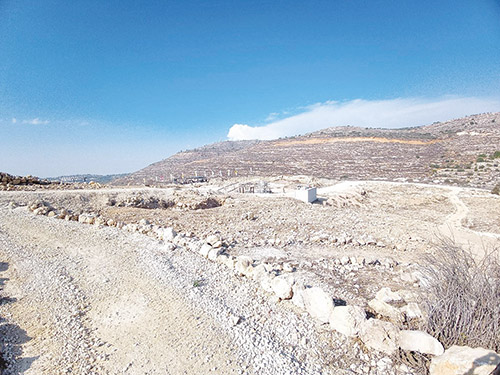
(The historical information in this article as well as the references to Torah sources are based on the information in ספר שילה, compiled by ד”ר אייל מירון, חנן ארליך and יהודה עציון.)
Every student at a Jewish yeshiva day school has learned about Elkanah’s heroic visits to Shiloh, where he reminded his Jewish brethren to join him and be oleh regel to Shiloh. They have learned of the pain of Chana, having been childless for many years, who pours her heart out to God and prays for a child. She promises that if God will grant her a child, she will dedicate him to God for his whole life. They have learned that the High Priest, Eli, thinks that she is drunk and she explains to him that no, she is not intoxicated, she is just pouring her heart out to God from her deep place of pain and anguish. Let’s explore the ruins of ancient Shiloh and learn about what we can see there today.
How do we know that the site advertised as ancient Shiloh, שילה הקדומה, is really such? Rabbi Ishtori HaParchi, author of the Kaftor V’Pherach, who traveled the land of Israel in the 14th century, describes how Shiloh can be identified today in the same way as it was during the time of the Shoftim. Shoftim 21:19 describes Shiloh as being north of Beit El and south of Levona. These names were preserved in the Arabic names of the towns and Siloon is south of the Arab town Luban a-Sharqiya (Levona). The modern excavations of Shiloh fit exactly that location. Additionally, a Greek inscription discovered at the site specifically mentions the “people of Siloon,” indicating that there was a clear tradition that this was the site of Shiloh.

So what can we see when we visit ancient Shiloh? If we walk toward the peak of the tel (archeological site), there is an impressive modern building which is called Migdal HaRo’eh or Tower of the Prophet. In this structure, one can see a film about the events from Tanach that occurred in Shiloh as well as visit a museum which houses the various artifacts that were discovered in the excavations in Shiloh. If one walks around the perimeter of this structure, he has a beautiful view of the mountains surrounding ancient Shiloh and the various contemporary yishuvim that sit on each one. Israel is full of beautiful views! What’s so special about this one? Whereas in Jerusalem, where all sacrifices had to be eaten within the walls, the Mishnah (Zevachim 14:6) teaches that when the Mishkan was in Shiloh, kadshim kalim and ma’aser sheni could be eaten as long as one could see the site of the Mishkan. That means that people could sit on all of the surrounding mountain tops and eat their parts of karbonot. Imagine what this place looked like during the shalosh regalim. I’ve heard it called a natural amphitheater.
Another exciting find of the excavations in Shiloh is the large storage area with many collar rim jars. The dating of this area corresponds to the time when the Mishkan stood in Shiloh. The tremendous quantity of food that was stored here indicates that this was a major center. Perhaps this is where food was stored to feed the many olei regel who came to Shiloh six times a year?
But where exactly on this site did the Mishkan stand? Is there any way to know? The Torah describes the dimensions of the Mishkan as being 100 amot long and 50 amot wide (Shemot 27:18). A clearing was found in the northern section of ancient Shiloh that would perfectly house the dimensions of the Mishkan. Why else would people of ancient times have cleared away so many rocks and flattened an area this size? It is quite likely that this was the site of the Mishkan!
This was where Chana came to pour her heart out in prayer and from where we learn the basic principles of prayer according to the Talmud Brachos 31A. It was here, to the Mishkan in Shiloh, that Shmuel HaNavi was brought as a young boy and raised by Eli, the Kohen Gadol. It was here that the messenger came to relay the death of Eli’s sons, Chofni and Pinchas, and the capture of the Aron Kodesh by the Plishtim. It’s incredible that we can stand in that same place and think about the many lessons which we can learn from these chapters of Navi. One lesson that we can learn from Chana is the power of sincere, heartfelt prayer. Chana did not complacently accept her fate. She knew that even against all natural odds, God could give her a child. Although her husband tried to console her, Chana refused to be comforted. She took action. She turned to the Father of all mankind and implored that He grant her a child. Whatever difficult situation we may be in life, there is always someone that we can turn to. Let’s learn from Chana to never give up.

Recognize this synagogue? Be the first to email the correct answer to havapreil@gmail.com and receive a free drink at Lazy Bean Café in Teaneck! Stay-tuned to learn more about it in our next article!
Hava Preil is an enthusiastic licensed Israeli tour guide. She grew up on the Upper West Side of Manhattan and holds a master’s degree in Judaic studies. Hava has developed and taught accredited courses in Tanach and Jewish ethics for Naaleh/Woodmont College and Cybersem. She lives in Givat Ze’ev, Israel with her family. Hava can be reached at IL:054-844-1579; (845) 391-0438 (U.S.) or at havapreil@gmail.com.











